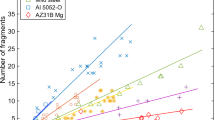Abstract
In many fragmentation processes, the probability P of obtaining debris with size x is proportional to \(x^{-\alpha }\) where \({\alpha }\) is the so-called critical exponent. Statistical distributions of this type are called power laws, and they are regarded as a fingerprint of the self-similar, or fractal nature, of the process. In the present paper, we present experimental data on the fragmentation process, performed at different temperatures, of various aromatic compounds with similar crystal structure but different thermodynamic properties. The statistical distribution of the debris size always follows a power law distribution over three decades or more for all compounds at all temperatures. The value of the critical exponent is generally higher at lower values of the grinding temperature. Our data are discussed in connection with the thermodynamic properties of the different materials. It is pointed out that a similar behaviour is also observed in the statistical distribution of the magnetization reversals taking place in thin ferromagnetic films under the effect of an applied magnetic field. This could be an indication of the existence of a more general mechanism acting in a similar way in these different systems.






Similar content being viewed by others
References
W.K. Brown, R.R. Karpp, D.E. Grady, Astrophys. Space Sci. 94, 401 (1984)
W. Bauer, S. Pratt, Phys. Rev. C 59, 2695 (1999)
N. Keule et al., J. Struct. Geol. 29, 1282 (2007)
E. Gudowska Nowak et al., Eur. Phys. J. 30, 317 (2009)
K. Kouroupis-Agalou et al., Nanoscale 6, 5926 (2014)
T. Kadono, M. Arakawa, Phys. Rev. E 65, 035107–1 (2002)
B. Venkoba Rao, A. Datta, Powder Technol. 169, 41 (2002)
Z.Y. Xia et al., Adv. Funct. Mater. 23, 4684 (2013)
T. Napier-Munn, Miner. Eng. 73, 1 (2015)
S. Levy, Ph.D. Thesis N. 4898, cole Polytechnique de Lausanne (2000)
P. Rosin, E. Rammler, J. Inst. Fuel 7, 29 (1933)
N.F. Mott, E.H. Linfoot, United Kingdom Ministry of Supply AC3348 (1943)
E.V. Schuhmann, AIME Tech. Publ. 1189, 1 (1941)
D.L. Turcotte, J. Geophys. Res. 91, 1921 (1986)
A. Clauset, C.R. Shalizi, M.E.J. Newman, SIAM Rev. 51, 661 (2009)
M.P.H. Stumpf, M.A. Porter, Science 335, 665 (2012)
E. Puppin, Phys. Rev. Lett. 84, 5415 (2000)
E. Puppin, M. Zani, J. Phys. Conds. Matter 16, 1183 (2004)
K. Kojima, A. Uedono, Defect Control in Semiconductors (Science Directi, 1990) (1673)
R. Ragu, A.S. Emarance, S.J. Das, IRJET 4, 393 (2017)
Source NIST Chemistry WebBook, SRD 69
P. Bak, C. Tang, K. Wiesenfeld, Phys. Rev. Lett. 52, 1033 (1984)
M. Davydova, S. Uvarov, Frattura ed Integrit Strutturale 24, 60 (2013)
H. Barkhausen, Z. Phys. 20, 401 (1919)
S. Zapperi, A. Vespignani, H.E. Stanley, Nature 388, 658 (1997)
S. Zapperi, P. Cizeau, G. Durin, Phys. Rev. B 58, 6353 (1998)
Acknowledgements
The author is indebted with Marco Moretti and Silvia Maria Pietralunga for reading the draft of this paper and for their stimulating comments.
Author information
Authors and Affiliations
Corresponding author
Rights and permissions
About this article
Cite this article
Puppin, E. Temperature-dependent power laws in the brittle fragmentation of solid aromatic compounds. Eur. Phys. J. Plus 135, 420 (2020). https://doi.org/10.1140/epjp/s13360-020-00398-5
Received:
Accepted:
Published:
DOI: https://doi.org/10.1140/epjp/s13360-020-00398-5




